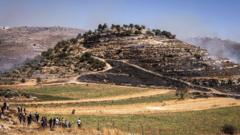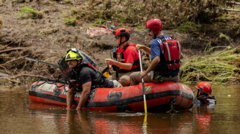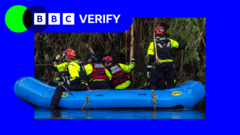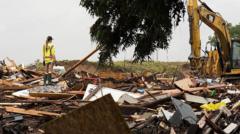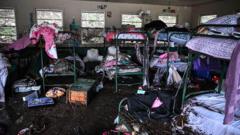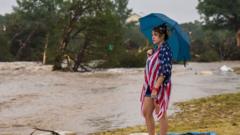Officials in Texas are grappling with serious concerns regarding the timeliness and effectiveness of emergency alerts after flash floods wreaked havoc, resulting in the deaths of 120 individuals, with many others still unaccounted for.
Questions Arise Over Emergency Communications as Texas Floods Claim Lives
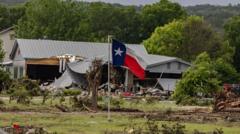
Questions Arise Over Emergency Communications as Texas Floods Claim Lives
Kerrville officials under scrutiny as delays in emergency alerts come to light following devastating floods that killed at least 120 people.
Kerrville, Texas, is facing increasing scrutiny as the community reels from deadly flash floods that have claimed 120 lives, including 36 children. The question on everyone’s lips is whether the local authorities acted swiftly enough in issuing emergency alerts.
The catastrophic flooding began on July 4, when an extraordinary 100 billion gallons of rain fell in rapid succession, leading to the Guadalupe River rising perilously. Residents of Kerrville were reportedly left in the dark about the unfolding disaster, as questions arise about a possible failure in police radio communications.
During a press conference, Kerrville community services officer Jonathan Lamb admitted, “I don’t have any information to that point,” when asked about the communication lapses. This came after a tense exchange with media who pressed for details on a delay in notifying residents. Alarmingly, records indicate that a firefighter upstream, sensing the imminent danger, had urged the Kerr County Sheriff's Office to issue a CodeRED alert around 04:22 local time. However, residents did not receive warnings until nearly six hours later, with the initial alert dispatched almost 90 minutes after the request.
The Kerr County Sheriff, Larry Leitha, mentioned during the press conference that he first became aware of the risk later in the morning and prioritized locating missing persons over timeframe assessments. As of now, more than 160 individuals are still unaccounted for.
Rescue efforts have been hampered by dangerous conditions, as officials attempt to sift through hazardous debris to locate victims buried underneath. The local authorities have cited challenges such as poor cell phone reception and the community’s desensitization to floods as contributing factors to insufficient evacuations.
Federal disaster declarations are now in place, allowing for assistance from the Federal Emergency Management Agency (FEMA) while recovery operations continue with the help of over 2,100 responders. "It's extremely treacherous and time-consuming," Lt Colonel Ben Baker remarked, shedding light on the extensive rescue operations ongoing in the area.
The unfolding crisis has sparked discussions around emergency preparedness and response in flood-prone regions, raising serious questions about accountability in the face of tragedy.
The catastrophic flooding began on July 4, when an extraordinary 100 billion gallons of rain fell in rapid succession, leading to the Guadalupe River rising perilously. Residents of Kerrville were reportedly left in the dark about the unfolding disaster, as questions arise about a possible failure in police radio communications.
During a press conference, Kerrville community services officer Jonathan Lamb admitted, “I don’t have any information to that point,” when asked about the communication lapses. This came after a tense exchange with media who pressed for details on a delay in notifying residents. Alarmingly, records indicate that a firefighter upstream, sensing the imminent danger, had urged the Kerr County Sheriff's Office to issue a CodeRED alert around 04:22 local time. However, residents did not receive warnings until nearly six hours later, with the initial alert dispatched almost 90 minutes after the request.
The Kerr County Sheriff, Larry Leitha, mentioned during the press conference that he first became aware of the risk later in the morning and prioritized locating missing persons over timeframe assessments. As of now, more than 160 individuals are still unaccounted for.
Rescue efforts have been hampered by dangerous conditions, as officials attempt to sift through hazardous debris to locate victims buried underneath. The local authorities have cited challenges such as poor cell phone reception and the community’s desensitization to floods as contributing factors to insufficient evacuations.
Federal disaster declarations are now in place, allowing for assistance from the Federal Emergency Management Agency (FEMA) while recovery operations continue with the help of over 2,100 responders. "It's extremely treacherous and time-consuming," Lt Colonel Ben Baker remarked, shedding light on the extensive rescue operations ongoing in the area.
The unfolding crisis has sparked discussions around emergency preparedness and response in flood-prone regions, raising serious questions about accountability in the face of tragedy.


